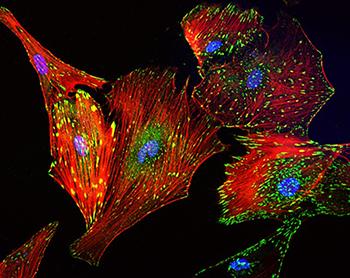
Duke Eye Center’s Basic Science Research Led to Development of the First New Glaucoma Drug to be FDA-Approved in 20 Years
The U.S. Food and Drug Administration (FDA) has approved a new drug for the treatment of glaucoma that was developed based on basic research conducted at Duke Ophthalmology.
In December 2017, the FDA approved Rhopressa® (netarsudil ophthalmic solution 0.02%) for the reduction of elevated eye pressure in patients with glaucoma. Rhopressa is the first new glaucoma drug class to be FDA-approved in 20 years, and the first to target and inhibit Rho kinase as a way to lower intraocular pressure.
The journey from discovery to drug development is a prime example of the bench-to-bedside translational research and teamwork taking place daily at Duke Ophthalmology.
Identifying a Novel Therapeutic Target
Glaucoma is a leading cause of irreversible blindness worldwide. In the U.S. alone, more than 2.5 million people suffer from glaucoma, and the impact here and abroad is expected to be increased significantly over the next decade.
Unfortunately, until now, glaucoma therapies aimed at lowering intraocular pressure (IOP) to delay progression of optic neuropathy and vision loss have not worked well in many patients – due, in part, to lack of a thorough understanding of the molecular and cellular mechanisms involved. Aqueous humor (AH), the clear fluid in the front portion of the eye, plays a crucial role in not only supplying nutrients to the lens, cornea and other avascular tissues but also in maintaining IOP, which is required for normal function of the eye. Decreased AH drainage/outflow resulting in the elevation of IOP is recognized to increase risk for primary-open angle glaucoma (POAG), a prevalent type of glaucoma. The most common glaucoma drugs have not specifically targeted the trabecular meshwork, the tissue that drains the AH and whose functional impairment underlies increased IOP.
 The late David Epstein, MD, former chair of the Department of Ophthalmology with Vasantha Rao, PhD, Professor of Ophthalmology.
The late David Epstein, MD, former chair of the Department of Ophthalmology with Vasantha Rao, PhD, Professor of Ophthalmology.Over the last 20 years, basic and preclinical research conducted at Duke Eye Center in the laboratory of Vasantha Rao, PhD, Professor of Ophthalmology, and pharmacology and Cancer Biology in collaboration with the late David Epstein, MD, former chair of the Department of Ophthalmology and a world-renowned glaucoma expert, has focused on elucidating the molecular mechanisms regulating trabecular meshwork contractile activity, cell shape, and cell adhesive interactions. The Rao laboratory identified and characterized Rho kinase, the key downstream signaling target of Rho GTPase, as a promising and novel therapeutic target for lowering IOP in glaucoma patients, and demonstrated that inhibition of Rho kinase increases AH outflow through the trabecular meshwork. These studies have been funded by the NIH and Research to Prevent Blindness.
Rao’s group not only identified Rho kinase as a therapeutic target, but also demonstrated the significance of dysregulation of this kinase signaling pathway in the pathobiology of ocular hypertension. Prior to joining the Duke, Rao’s work at the National Eye Institute demonstrated a role for Rho GTPase function in ocular lens development and architecture. These earlier studies helped Rao hypothesize that inhibition of Rho kinase might lower IOP in glaucoma patients.
Prior to joining the Duke, Rao’s work at the National Eye Institute demonstrated a role for Rho GTPase function in ocular lens development and architecture. These earlier studies helped Rao hypothesize that inhibition of Rho kinase might lower IOP in glaucoma patients.
From the Laboratory to the Patient
While work on Rho kinase was progressing at Duke, Epstein, in collaboration with former Duke Professor of Chemistry Eric Toon, PhD, and pharmaceutical industry veteran Casey Kopczynski, PhD, formed the company Aerie Pharmaceuticals. Using the protocol developed by Rao and Epstein for screening Rho kinase inhibitors, Aerie scientists discovered the active ingredient in Rhopressa® (netarsudil), which in preclinical and clinical studies was found to lower IOP primarily by increasing AH outflow through the trabecular meshwork. The new drug performed well in human clinical trials, and late last year, the FDA officially approved Rhopressa® for the reduction of elevated intraocular pressure in patients with open-angle glaucoma or ocular hypertension. The ophthalmic solution will be available in spring 2018.